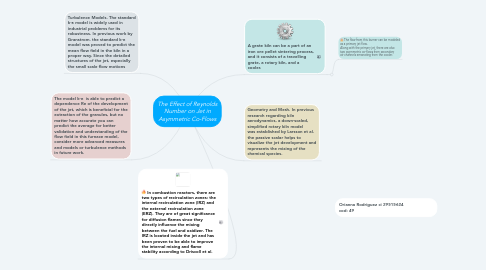The Effect of Reynolds Number on Jet in Asymmetric Co-Flows
by ori rodriguez

1. The model k-ε is able to predict a dependence Re of the development of the jet, which is beneficial for the extraction of the granules, but no matter how accurate you can predict the average for better validation and understanding of the flow field in this furnace model, consider more advanced measures and models or turbulence methods in future work.
2. In combustion reactors, there are two types of recirculation zones: the internal recirculation zone (IRZ) and the external recirculation zone (ERZ). They are of great significance for diffusion flames since they directly influence the mixing between the fuel and oxidizer. The IRZ is located inside the jet and has been proven to be able to improve the internal mixing and flame stability according to Driscoll et al.
3. Turbulence Models. The standard k-ε model is widely used in industrial problems for its robustness. In previous work by Granstrom. the standard k-ε model was proved to predict the mean flow field in the kiln in a proper way. Since the detailed structures of the jet, especially the small scale flow motions
4. A grate kiln can be a part of an iron ore pellet sintering process, and it consists of a travelling grate, a rotary kiln, and a cooler.
4.1. The flow from this burner can be modeled as a primary jet flow. Along with the primary jet, there are also two asymmetric co-flows from secondary air channels emanating from the cooler.
5. Geometry and Mesh. In previous research regarding kiln aerodynamics, a down-scaled, simplified rotary kiln model was established by Larsson et al. the passive scalar helps to visualize the jet development and represents the mixing of the chemical species.
6. Orianna Rodriguez ci 29515624 cod: 49


